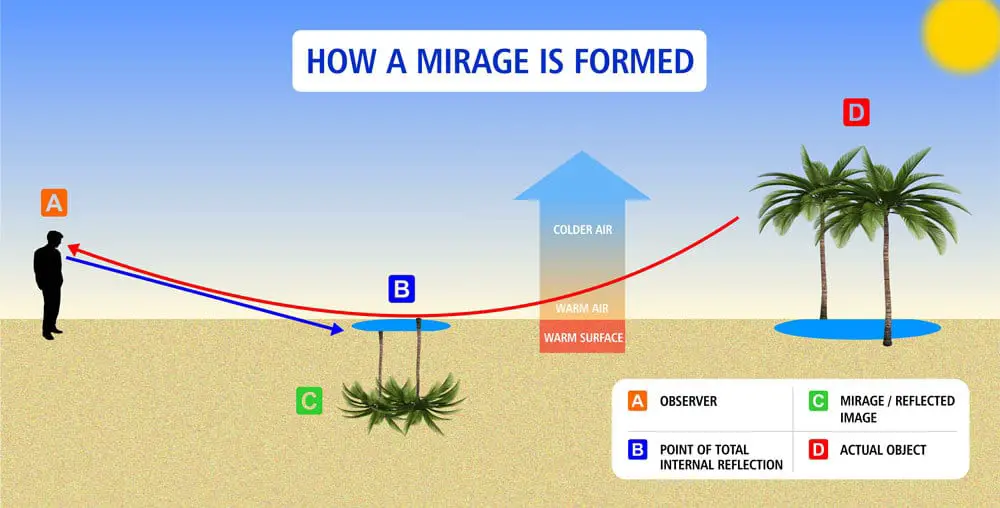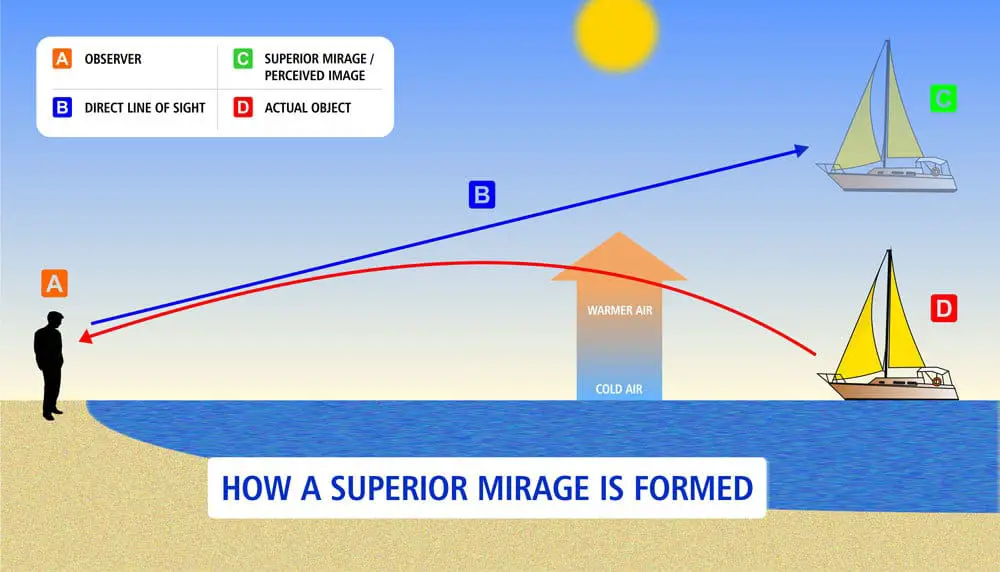What Is A Mirage, And How Does It Occur?
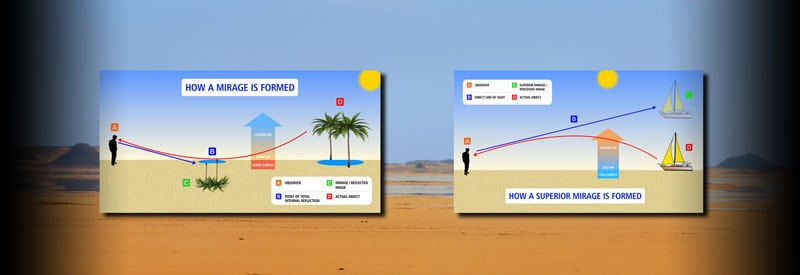
Many readers will be familiar with a scene in a movie depicting a lost person seeing a distant "lush oasis" in the desert, only to find nothing but sand upon arrival. This optical phenomenon is known as a mirage.
A mirage is defined as a naturally occurring optical phenomenon that results from the refraction of light rays, causing distant objects to appear much closer than they are. It typically occurs on warm days when surface air temperatures are much warmer than the air above it in the atmosphere.
This phenomenon can also be seen when you travel on a long stretch of road on a hot day, and you spot a large puddle of water at a distance. As you approach it, it continues to move further away.
Your eyes are not playing tricks on you, and you are not hallucinating. What you experience is nothing more than an optical distortion called a mirage.
In this article, we explore what precisely a mirage is, how it is formed, and also look at the different types of mirages.
What Is A Mirage?
A mirage needs a combination of different variables to be in place for this phenomenon to take shape. Before we delve into a thorough explanation, it is important to have a short description to summarize what a mirage is:
Mirage Definition
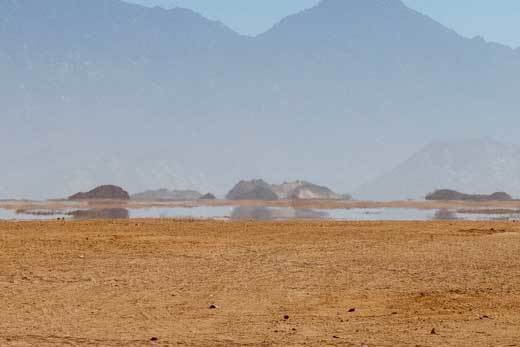
A mirage is an optical distortion that occurs naturally due to the refraction of light rays that creates a deceptive appearance of a distant object. It typically occurs on a hot day when the surface temperature and the air directly above it are much warmer than the air higher up in the atmosphere.
It is a simplified and concise summary of an event that needs a more detailed explanation to understand how it occurs and what mechanisms are at play during the process.
How Is A Mirage Formed?
The word mirage was directly borrowed from the french verb, mirer, which originated from the Latin word, mirari, which translates to "mirror" or "to look at." As you will shortly learn, this is quite an accurate description of the phenomenon.
Mirages can be divided into two types of optical distortions:
- Inferior Mirage
- Superior Mirage
By looking at them individually, it will soon become clear how each phenomenon is formed and why we see (or perceive) the resulting image in the way we do.
Inferior Mirage
The most familiar and commonly occurring form of this optical distortion is the inferior mirage. It can be seen on a hot day while traveling on a long stretch of road or in the desert, where the phenomenon first gained wide recognition.
A mirage is capable of producing a misplaced image of an object due to the capability of light to refract (bend) in a medium with non-uniform uniform attributes.
It is widely assumed that light travels in a straight path, especially at a speed of 299 792 kilometers per second (186 282 miles per second). In the vacuum of space, it does indeed travel in a straight line.
When traveling through a medium like the atmosphere, the difference in air density at different altitudes allows light to bend. This is because light always follows the quickest path, not the shortest path.
The illustration below will clarify how and why light behaves in this fashion and how it contributes to the creation of a mirage:
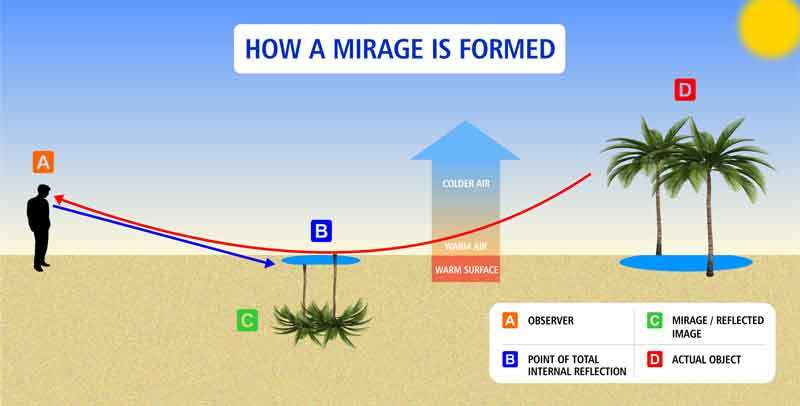
Illustration showing how an Inferior Mirage is formed. Click on the image for a larger view.
By making use of the illustration above, it will be much easier to explain and understand how an inferior mirage gets formed.
On a hot day, the Sun rapidly warms up the Earth's surface, which in turn heats the air directly above the ground. It creates a substantial difference in air temperature between the warm air near the surface and the colder air above it.
A medium with non-uniform properties has now been created with cold air, which is optically more dense, situated above warm air, which is optically less dense.
Since light always follows the quickest past, and warm air with less resistance is much faster to travel through, the light will bend towards the hot air close to the ground.
As the red line in the illustration shows, light travels from objects higher up in the colder air to the warm air close to the ground before bending back towards the eyesight of the observer.
The position where the light is not refracted anymore but reflects up towards the observer is called the point of total internal reflection. It is at this location where you will perceive the phenomenon to be located, when the actual object may, in fact, be hundreds of miles away.

To simplify and make the description of a mirage easy to understand, an identical inverted image of the palm trees and water was used in the illustration. Although this is possible, more often than not, the objects in a mirage may appear to look like something it is not.
For example, the "water" you see may be nothing more than the blue sky reflected on the ground, and the palm trees may be a completely different object that got distorted as the light traveled through layers of hot and cold air. There may not even be a real object at all.
In summary:
- An inferior mirage appears as a result of light bending towards warm air close to the ground, as the red line indicates.
- It is possible since light follows the quickest (not shortest) path, which, in this case, is the warmer air near the ground, which provides less optical resistance.
- The observer sees the distorted image much closer than it really is since the image is viewed via a direct line of sight by the observer, as indicated by the blue line.
The mirage is an optical distortion, meaning the image you see may be a distorted view of an actual object much further away. It can also show distortions that are not even part of the real object (e.g., the sky). It may even display items that don't even exist.
Superior Mirage
A superior mirage operates on precisely the same principles as an inferior mirage but has the exact opposite effect. Instead of showing an object much closer than it is, it displays an image of a distant object (that may be entirely out of view) on or above the horizon.
This type of mirage is a result of cold air that is trapped underneath a layer of warm air. This phenomenon is called temperature inversion (which you can read more about in this article.) As a result, light bends up, instead of down, towards the warmer air.
The illustration below will help to describe how a superior mirage gets formed:
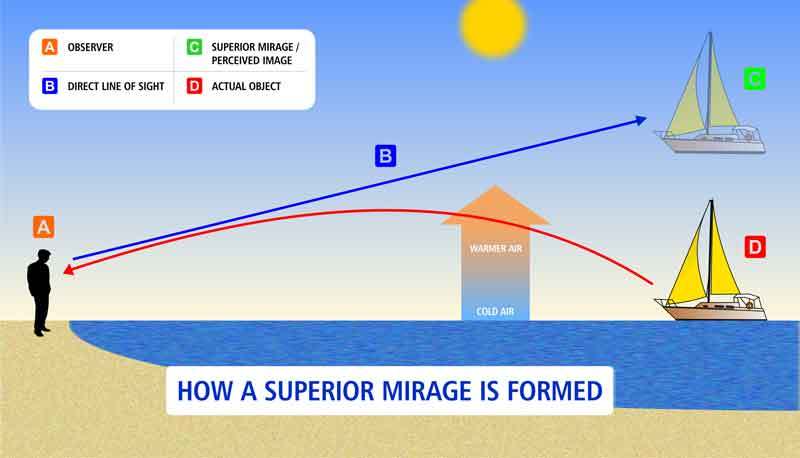
Illustration showing how an Superior Mirage is formed. Click on the image for a larger view.
By making use of the illustration above, it will be easier to explain and understand how a superior mirage gets formed.
A superior mirage mostly occurs over the colder waters of the ocean or in the Arctic. The cold surface of the water or ice cools down the air directly above it, with a layer of warmer air lying on top of it.
In the case of this phenomenon, the light gets refracted up towards the warmer air, where it can travel faster before getting reflected back down towards the sight of the observer, as indicated by the red line in the illustration.
As a result, the observer perceives the object to hover above his/her eyesight and the horizon, as indicated by the blue line in the illustration. This occurrence is called looming.

Sometimes, you can observe this phenomenon while standing on the shoreline and watch a boat on the horizon, which seems to float in the air some distance above the water.
Superior mirages also occur when objects too far away to see due to their distance & curvature of the planet "appears" above the horizon. This is possible due to the bending of light up towards the warmer air and then back down to the observer far away.
In summary:
- A superior mirage appears as a result of light bending up towards warmer air situated above colder air near the surface, as the red line indicates.
- It is possible since light follows the quickest (not shortest) path, which, in this case, is the warmer air higher in the atmosphere, which provides less optical resistance.
- The observer sees the distorted image "floating" above the horizon since the image is viewed via a direct line of sight, as indicated by the blue line.
Conclusion
As this article illustrated, a mirage is not your eyes playing tricks on you. It is a real distorted image you see as a result of the refraction (bending) and reflecting of light. It is your brain that is programmed to interpret that what you see is something completely different.
Often, it is the image of an actual object at a distant location, sometimes it is a distorted image that appears as something completely different, and sometimes there is no real object at all.
Through this post, you learned what a mirage is, what the different types of mirages are, and how each one develops.
Never miss out again when another interesting and helpful article is released and stay updated, while also receiving helpful tips & information by simply clicking on this link .
Until next time, keep your eye on the weather!

